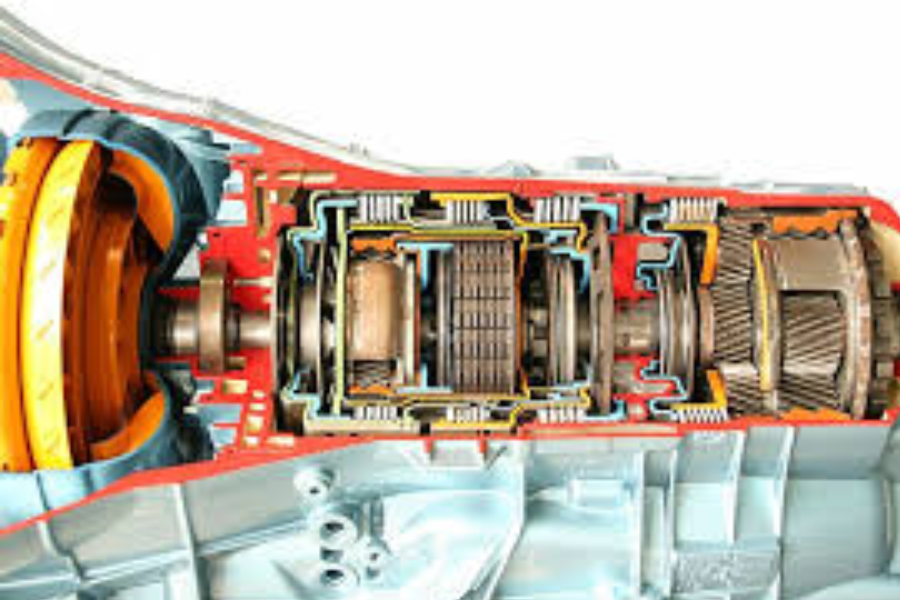Understanding the ZF 6HP Generation 2 Transmission: A Comprehensive Guide to Solenoids
When it comes to automotive transmissions, the ZF 6HP Generation 2 is a name that often comes up, known for its reliability and exceptional performance. This transmission system is widely used in many vehicles, from luxury sedans to high-performance SUVs. But what happens when this seemingly flawless transmission starts to show signs of trouble? Often, the culprit lies within a small yet powerful component known as a solenoid.
In this article, we’ll dive deep into the world of solenoids, exploring their crucial role in the ZF 6HP Generation 2 transmission. We’ll break down the different types of solenoids used, explain how to read and understand a solenoid diagram, and provide tips for troubleshooting and maintaining these vital components. Whether you’re a seasoned mechanic or a DIY enthusiast, this guide will equip you with the knowledge you need to keep your vehicle’s transmission running smoothly.
What Are Solenoids and Their Function in the Transmission?
Solenoids are integral components in the operation of automatic transmissions like the ZF 6HP Generation 2. Essentially, a solenoid is an electromechanical device that controls the flow of fluid within the transmission, which in turn affects gear shifts and overall vehicle performance.
Here’s how it works: when an electrical current passes through a solenoid’s coil, it generates a magnetic field. This magnetic field then causes a plunger or valve inside the solenoid to move, either opening or closing a passage within the transmission’s hydraulic circuit. By controlling fluid flow, solenoids regulate hydraulic pressure, ensuring that the right amount of pressure is applied to the appropriate clutches and bands within the transmission. This precise control is what allows for smooth and efficient shifting between gears.
Without functioning solenoids, the transmission would be unable to shift gears smoothly, leading to rough or delayed shifts, and in severe cases, complete transmission failure. This is why understanding how solenoids work and knowing how to maintain them is crucial for anyone looking to ensure the longevity and performance of their vehicle’s transmission.
Types of Solenoids Used in the ZF 6HP Generation 2 Transmission
The ZF 6HP Generation 2 transmission utilizes several types of solenoids, each serving a specific function within the system. Understanding these different types is key to diagnosing and repairing transmission issues.
1. Pressure Control Solenoids
Pressure control solenoids are responsible for regulating the hydraulic pressure within the transmission. These solenoids adjust the pressure based on engine load, vehicle speed, and other driving conditions to ensure that the transmission shifts smoothly and efficiently. If a pressure control solenoid fails, it can lead to harsh or erratic shifting, as the transmission may receive incorrect pressure levels.
2. Shift Solenoids
Shift solenoids are directly involved in the process of changing gears. They control the engagement and disengagement of clutches and bands that determine which gear the transmission is in. When a shift solenoid fails, you may experience problems such as the transmission getting stuck in a particular gear or failing to shift altogether.
3. Torque Converter Lock-Up Solenoids
The torque converter lock-up solenoid plays a critical role in improving fuel efficiency, especially during highway driving. At certain speeds, this solenoid engages the torque converter lock-up clutch, creating a direct connection between the engine and transmission. This reduces slippage and allows for better fuel economy. A malfunctioning lock-up solenoid can lead to poor fuel efficiency and can cause the vehicle to shudder or stall at low speeds.
Understanding the different types of solenoids and their functions can help you diagnose issues more effectively and ensure that you replace the correct component when necessary.
How to Read and Understand a Solenoid Diagram for the ZF 6HP Generation 2 Transmission
For many, the idea of reading a solenoid diagram can be intimidating, especially if you’re not familiar with the symbols and terminology used in these technical documents. However, once you break it down, a solenoid diagram is a valuable tool that can help you understand how the transmission operates and where potential problems may lie.
1. Identify Key Components
The first step in reading a solenoid diagram is to identify the key components. Look for labels or symbols that indicate the different solenoids within the transmission, such as “Shift Solenoid A,” “Pressure Control Solenoid B,” or “Torque Converter Lock-Up Solenoid.” These labels will help you understand which part of the transmission each solenoid is controlling.
2. Understand the Wiring Connections
The lines on the diagram represent electrical connections between components. By following these lines, you can trace the path of electrical current as it flows through the transmission system. This is crucial for diagnosing issues related to wiring or electrical malfunctions. If you notice that a particular solenoid is not receiving power, you can use the diagram to trace the wiring back to its source and check for any issues.
3. Pay Attention to Color Coding
Some solenoid diagrams use color coding to differentiate between different types of connections or to indicate the operating state of a solenoid. For example, red lines might represent power connections, while blue lines represent ground connections. Understanding this color coding can make it easier to interpret the diagram and identify potential issues.
4. Refer to the Legend
Most solenoid diagrams include a legend or key that explains the symbols and abbreviations used in the diagram. Be sure to refer to this legend as you read the diagram, as it will help you understand what each symbol represents. The legend might also provide additional information, such as voltage levels or specific diagnostic codes.
By familiarizing yourself with the layout and symbols used in solenoid diagrams, you’ll be better equipped to diagnose and repair transmission issues related to solenoids.
Troubleshooting Common Issues with Solenoids in the ZF 6HP Generation 2 Transmission
Even with the best maintenance practices, solenoids can still encounter issues over time. Knowing how to troubleshoot these problems can save you time and money, and help you avoid more serious transmission failures.
1. Delayed or Erratic Shifting
One of the most common signs of solenoid issues is delayed or erratic shifting. If you notice that your vehicle hesitates before shifting into the next gear or shifts with a jolt, a malfunctioning solenoid could be to blame. Pressure control solenoids are often the culprits in these situations, as they regulate the hydraulic pressure needed for smooth gear changes.
2. Stuck in Gear
If your transmission becomes stuck in a particular gear and refuses to shift, this is a clear indication of a problem with one of the shift solenoids. This issue can be especially problematic if it occurs in a higher gear, as it can make the vehicle difficult to drive at low speeds.
3. Warning Lights and Error Codes
Modern vehicles are equipped with onboard diagnostic systems that can detect issues with solenoids and other transmission components. If you see a warning light related to your transmission or if your diagnostic scanner shows an error code related to a solenoid, don’t ignore it. These codes can provide valuable insight into which solenoid is malfunctioning and what steps you need to take to fix it.
4. Unusual Noises
Unusual noises such as whining, buzzing, or grinding can indicate a problem with a solenoid. These noises are often the result of a solenoid that is not opening or closing properly, causing fluid to flow incorrectly within the transmission. If you hear any of these noises, it’s important to inspect the solenoids and their associated components as soon as possible.
5. Transmission Slipping
If your transmission seems to slip out of gear while driving, this could be a sign that a solenoid is not maintaining the proper hydraulic pressure. Slipping can lead to excessive wear on the transmission and should be addressed immediately.
Regularly checking your transmission’s performance and being aware of these common symptoms can help you catch solenoid issues early, preventing more extensive damage to your transmission.
Tips for Maintaining and Replacing Solenoids in the ZF 6HP Generation 2 Transmission
Maintaining solenoids in your ZF 6HP Generation 2 transmission is essential for ensuring the long-term health of your vehicle. Here are some tips to keep in mind:
1. Regular Inspections
Regular inspections of your transmission system can help you catch potential issues before they become major problems. During these inspections, check for signs of wear or damage around the solenoid connections. Look for any signs of corrosion, fluid leaks, or damaged wiring, as these can all lead to solenoid malfunctions.
2. Use OEM Parts
When it comes time to replace a solenoid, always use Original Equipment Manufacturer (OEM) parts. OEM parts are specifically designed to work with your transmission and will ensure compatibility and reliability. While aftermarket parts may be cheaper, they may not provide the same level of performance or durability.
3. Clean the Area Thoroughly
Before installing a new solenoid, make sure the area around the solenoid is clean and free of debris. Dirt and grime can cause the solenoid to malfunction or wear out prematurely. Use a clean, lint-free cloth to wipe down the area before installation.
4. Follow Torque Specifications
When reassembling the transmission after replacing a solenoid, it’s important to follow the manufacturer’s torque specifications. Over-tightening bolts can damage the solenoid or surrounding components, while under-tightening can lead to fluid leaks and other issues.
5. Monitor Transmission Performance
After replacing a solenoid, closely monitor your transmission’s performance. Pay attention to how the vehicle shifts and listen for any unusual noises. If you notice any issues, it may indicate that the new solenoid is not functioning properly or that there are other underlying problems.
Facts:
- ZF 6HP Generation 2 Transmission: Known for its reliability, this transmission is widely used in various luxury vehicles and high-performance SUVs.
- Solenoids’ Role: Solenoids in the ZF 6HP Generation 2 transmission regulate hydraulic pressure and control fluid flow to ensure smooth gear shifts.
- Types of Solenoids:
- Pressure Control Solenoids: Regulate hydraulic pressure based on driving conditions.
- Shift Solenoids: Manage the engagement and disengagement of clutches and bands for gear changes.
- Torque Converter Lock-Up Solenoids: Improve fuel efficiency by engaging the torque converter lock-up clutch at certain speeds.
- Troubleshooting: Common solenoid issues include delayed or erratic shifting, getting stuck in gear, and unusual noises.
- Maintenance Tips: Regular inspections, using OEM parts, and following proper installation procedures are essential for maintaining solenoid functionality.
Summary
The ZF 6HP Generation 2 transmission is renowned for its reliability and is widely used in luxury sedans and high-performance SUVs. However, issues may arise, often due to malfunctioning solenoids, which are crucial components that control fluid flow and pressure within the transmission, thereby regulating gear shifts. The article delves into the different types of solenoids used in this transmission—pressure control solenoids, shift solenoids, and torque converter lock-up solenoids—and explains their specific functions. It also provides guidance on how to read solenoid diagrams, troubleshoot common issues like delayed shifting and being stuck in gear, and maintain or replace solenoids effectively.
FAQs:
1. What are solenoids, and why are they important in the ZF 6HP Generation 2 transmission?
Solenoids are electromechanical devices that control the flow of fluid within the transmission. They regulate hydraulic pressure, which is essential for smooth gear shifts and overall vehicle performance.
2. What types of solenoids are used in the ZF 6HP Generation 2 transmission?
The transmission uses three main types of solenoids: pressure control solenoids, shift solenoids, and torque converter lock-up solenoids, each serving a specific function in managing fluid flow and pressure.
3. How can I troubleshoot solenoid issues in my ZF 6HP Generation 2 transmission?
Common symptoms of solenoid issues include delayed or erratic shifting, being stuck in gear, and unusual noises. Using a diagnostic scanner to check for error codes can also help identify which solenoid may be malfunctioning.
4. What should I consider when replacing a solenoid in the ZF 6HP Generation 2 transmission?
Always use OEM parts for replacements, clean the area thoroughly before installation, and follow the manufacturer’s torque specifications to ensure proper installation.
5. How can I maintain the solenoids in my transmission to prevent issues?
Regularly inspect your transmission system for signs of wear, damage, or fluid leaks. Keeping the area around the solenoids clean and using quality parts will help maintain their functionality and extend the life of your transmission.







